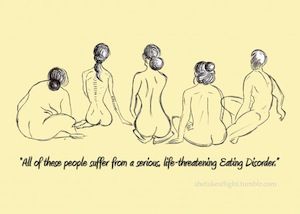
Helen Yates, Contributing Writer |
Approximately 30 million people in America suffer from an eating disorder, according to the National Association of Anorexia Nervosa and Associated Disorders (ANAD), yet there are many myths regarding anorexia, bulimia, and other eating disorders. As ANAD cites, anorexia nervosa has the highest mortality rate of all mental conditions, and other eating disorders can also take their toll on the body, both in the short- and long-term. It is vital for Americans to be aware of common myths surrounding the nature of eating disorders so they can ensure that they or their loved ones get the help they need when necessary.
Myth 1: Eating Disorders are a Teen Girls’ Issue:
While it is true that the most common age of onset is 16-19, according to AnorexiaBulimiaCare.org, people of all ages are affected by this condition. Although it is not often addressed, ANAD estimates that one-third of those suffering from an eating disorder are actually males. Eating disorders are underreported by men due to shame, societal stigma, and misconceptions; furthermore, boys and men are often underdiagnosed or misdiagnosed, because eating disorders manifest themselves in different ways in males than they do in females. In males, for instance, the focus tends to be on obtaining a lean, ripped physique (rather than on ‘thinness’) and excessive exercise can be the main indicator that something is wrong. One of the most worrisome group of people eating disorders affect are pregnant women, who often struggle between their desire to stay slim and the inevitable changes their body will undergo. It is vital to help all people affected by eating disorders. This is a life-or-death situation, so don’t ignore the signs of an eating disorder from someone of any demographic. Only one in 10 people suffering from an eating disorder will ever recieve treatment, cites Mirasol.net.
Myth 2: People with Eating Disorders Look Thin:
Not all eating disorders involve severely cutting calories. While those in advanced stages of anorexia nervosa do take on an excessively thin appearance, those in earlier stages may not show signs of excessive weight loss. Moreover, bulimia nervosa, another serious eating disorder which involves bingeing and purging, may not result in weight loss; in fact, some people can actually gain weight. The damage often occurs on the inside – to vital organs, teeth, etc.
Myth 3: There are Only Two Types of Eating Disorders – Anorexia and Bulimia:
Although these two eating disorders are the best known, there are other eating disorders we should be aware of, including Binge Eating Disorder (BED). This is similar to bulimia in that regular bingeing takes place, but no purging is involved. Those suffering from this disorder usually binge when they are alone, feeling extremely guilty during bingeing and/or afterwards. Another lesser known eating disorder is Other Specified Feeding or Eating Disorder (OSFED). Despite OSFED being relatively unknown, about 40-60 percent of all people diagnosed with an eating disorder actually have OSFED, according to EatingDisorder.org! A diagnosis of OSFED is usually made to someone who does not meet all the criteria for anorexia nervosa, bulimia nervosa, or BED. This person may count calories, for instance, yet not starve themselves as much as someone diagnosed with anorexia. They may exercise excessively to the point of exhaustion or injury.
Myth 4: When a Person with an Eating Disorder Recovers to a Normal Weight, They are Cured:
Weight recovery is the number one aim for someone suffering from an eating disorder such as anorexia nervosa, yet even when one gains a decent amount of weight, it is crucial for them to continue with therapy (counselling, nutrition and, if possible, family therapy) to slowly build a healthy relationship with food. Eating disorders have also been linked to other mental conditions such as depression and anxiety, so patients should be diagnosed and treated for any other conditions they may have. Families and patients alike should see their progress as a lifetime journey.
Myth 5: Eating Disorders are the Product of Pushy Parenting and Perfectionism:
This myth is harmful to both the person suffering from an eating disorder and their parents. Many studies on families and twins have shown that genetic factors cause an eating disorder in about half of cases, according to ANAD. Results indicate, for instance, that having a family member with an eating disorder can increase someone’s likelihood of developing one by 7-12 times, as stated on EatingDisorder.org. The focus should always be on recovery rather than fault-finding. Top-rated treatments such as Maudsley Family Therapy emphasize the need for the entire family to pull together to support the person in crisis. Goals include weight gain and fostering greater independence with respect to food. Support, information, and dedication are key when it comes to beating an eating disorder.
Leave a Reply